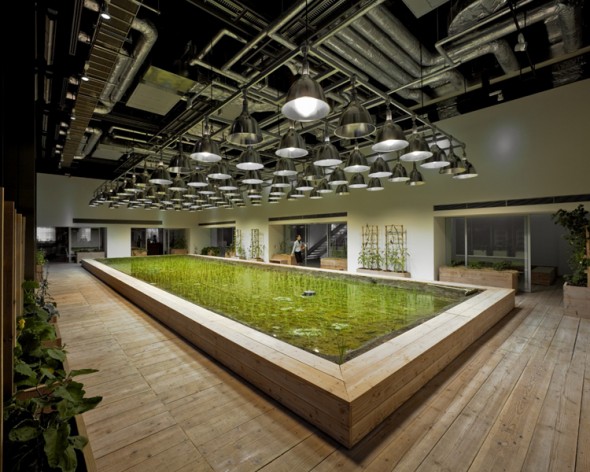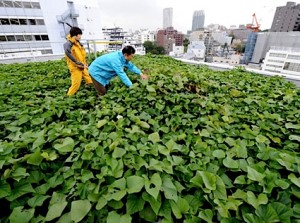Sophie Feng writes on one answer to disaster-prone Tokyo’s interest in food health and security. Corporate Ecology is mixed with the move toward Agricultural Urbanism, greening the sterile downtown office world for workers and visitors.


Downtown Tokyo “Office Farm” Takes Green Building to New Heights
By Sophie Feng in Asia Society Blog
Ripe tomatoes hang from conference room ceilings, rice paddies grow waist-high in the lobby, and a living façade of flowers and orange trees covers the expanse of the building’s exterior. There’s no shortage of agricultural variety around the Pasona office building, located in downtown Tokyo, Japan. In total, over 200 species of fruits, vegetables, and rice live within Pasona, including lemons, broccoli, salad greens, berries, squash, eggplant, and passion fruit.
[vimeo clip_id="70848522" width=600 height=338 ]
Video for Monocle magazine on Pasona headquarters in Tokyo, part of a three city study on urban farming.
Over 43,000 square feet of space is dedicated to the vegetation, and together with the automatic irrigation system and HEFL, fluorescent, and LED lighting, this office space is essentially a complete indoor ecosystem.


Since launching its agriculture project with its underground farm (Pasona O2) over eight years ago, the Pasona Group — a renowned temporary staffing and recruiting agency — has fully committed to the advancement of urban agriculture by providing community workshops that train younger generations of urban farmers. Pasona initially embarked on the project with the intention of creating jobs in the agricultural sector. But given its use of the latest hydroponic, lighting, and soil technologies, the company has emerged as an urban agriculture pioneer in Tokyo.
While fruits and vegetables can be seen growing on city dwellers’ balconies from Singapore to Seoul, this trend has gained momentum in disaster-prone Japan, spurred on most significantly by the nuclear meltdown in Fukushima. “Fukushima absolutely triggered a greater interest in urban gardening,” Justin Potts of Umari, a Tokyo-based group that organizes agricultural and business projects, told The Diplomat. “The reason for this is understandable. People want to know where their food comes from.”
While visitors are free to enter the lobby and see the farm for themselves, the employees actually contribute directly to the farm-to-office-table initiative; they work with a managing team to maintain, harvest, and prepare the produce for the on-site cafeteria. The resulting meals are fresh in quality, and the direct exposure to the seed-to-fruit process raises office- and community-wide awareness of food supply demands.


The Pasona Group has a traditional farm in Ogata, but with Pasona O2 in their Otemachi headquarters they want the “freeters” (underemployed Japanese who hop between part time jobs) to get a taste of “underground” farming, so to speak. It also is open to middle-aged people in search of a second career. There are a thousand square meters (10,000 SF) growing 100 different kinds of produce. It is all very energy-intensive; we would prefer to see more use of Parans type piped natural light or heliostats but this could be the start of a new underground movement. — Lloyd Alter, Treehugger
As with all innovative projects, this indoor farm isn’t free of faults. The energy used to power the lighting may not be the most efficient compared to conventional farming methods, and some may find the sterile environment unsettling and abnormal. Rather than regard its indoor farm as a perfect prototype, however, Pasona sees it as an experiment, the lessons from which will almost certainly inform new and improved urban agriculture ventures in the years to come.
Sophie Feng is a contributor to Asia Blog. A native New Yorker, she studies Film and Health Sciences at Rice University.









Pingback: Landscape Urbanism: Green Roofs, Community Farms in Japan | WilderUtopia.com
Pingback: Chicago: Does Indoor Vertical Farming Matter? | WilderUtopia.com
Pingback: Gardening in the Office | paskettpr
Pingback: Welcome to the Salad Bowl: Tokyo Workplace Offers Unique Benefits - Norwex Movement
Pingback: Rucola-pauze | Moestuinmoeder
I want to get a training on roof Top Garden
Sure, we can help. Send an e-mail to terraafont@gmail.com .